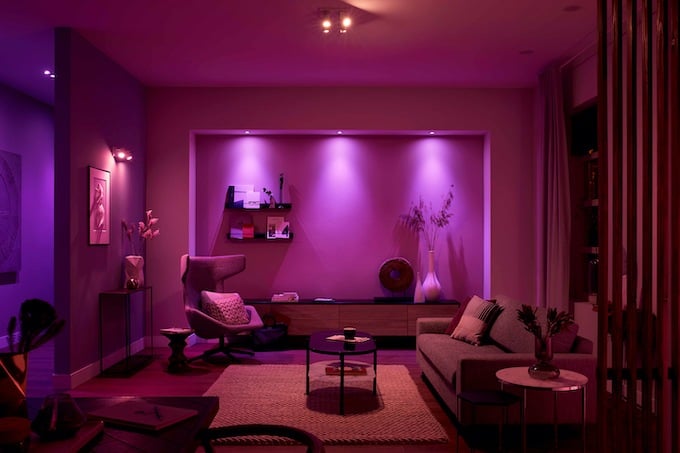We shine a little light on the subject
When it comes to high-end smart lighting, there are two companies that dominate the landscape: Philips Hue and LIFX. Both companies offer a wide range of products and price points, but Philips Hue is more well-known.
If you’re just entering the world of smart lighting, it can be tough to decide which company to go with. This guide will look at each company’s strengths and weaknesses to help you make the right choice for your home.

Philips Hue Vs LIFX Brightness, Color, and Power
The A19 LIFX bulbs put out slightly more light than Philips Hue bulbs. LIFX bulbs produce 1,100 lumens versus the 800 produced by Philips Hue, but they do so at the cost of more energy—11 watts compared to 10. Of course, this difference is so miniscule that unless you count every penny of your utility bill, you won’t notice.
Both Philips Hue and LIFX support up to 16 million colors. However, LIFX bulbs are widely regarded as producing more vibrant colors than Philips Hue bulbs. By that we mean that colors seem deeper. But unless you compare the two side-by-side, it will be hard to tell a difference.
Product Lineup
When the products first entered the market, Philips Hue had a clear lead due to the small number of competitors. LIFX offered only a limited selection of bulbs, while Hue had a variety of ambient lighting options. Now that gap is smaller, with both companies possessing a large number of products to choose from—but Hue still has the better lineup.
LIFX capitalizes on their vibrance of color and caters to the RGB-friendly crowd. The LIFX Beam, Z LED strip, and other bulbs utilize LIFX’s patented Polychrome technology, allowing a single bulb to produce multiple different colors at once.

LIFX lights also have the ability to create different patterns, allowing for a wave-like appearance, the flicker of a candle, and multiple blended colors, all thanks to the same technology.
While Philips Hue doesn’t have Polychrome capabilities, the company has a product roster that fits nearly every possible need. With seven different starter kits to choose from, as well as recessed lighting, light strips, pendant lights, and more, Philips Hue has a product for every situation.
In terms of online shopping, Philips Hue has the easier interface. It is well-organized and easier to browse for products than the LIFX store.
Third Party Support
Philips Hue is compatible with a much broader range of products than LIFX. The Philips name carries with it a certain level of recognition, and the company’s age has allowed them to build connections that the much-younger LIFX has not yet been able to do.

Philips Hue is compatible with HomeKit, Alexa, Google Assistant, SmartThings, and IFTTT. Hue also works with third-party companies like Xfinity and Razer to produce interesting, targeted lights. Hue also works with a variety of dimmers and other types of switches to give even more in-home control of the lights.
LIFX isn’t a slouch in this category, either. Aside from working with HomeKit, LIFX also works with Google Assistant and Alexa, as well as Microsoft’s nearly-forgotten Cortana. While LIFX doesn’t have the same number of accessories and third-party products that Hue does, the number of compatible products continues to grow.
Price
Here’s something to keep in mind from the start: Neither LIFX or Philips Hue is exactly budget-friendly. Both have high per-bulb costs, and some of the additional accessories are downright budget-busting.
Philips Hue can cost quite a bit to get started. The Hue White Ambiance Starter Kit starts at $120 with four bulbs and the Hue Bridge. If you want the ability to change the colors of the bulbs, you’ll need the Hue White and Color Ambiance Starter Kit, which starts at $200.
LIFX has a lower upfront cost to get started. A single bulb is $44, but it connects directly to your Wi-Fi network without the need for a hub. While the per-bulb cost for LIFX is higher, the upfront costs are more affordable—and you don’t need a hub to connect, which can be a big draw for many users.
Philips Hue Vs LIFX: Which Should I Buy?
The right smart bulb for you depends on what you plan to use it for. If you want to get into whole-home smart lighting with easy voice- and app-control, Philips Hue will be the most affordable option in the long run, particularly if you stick to only white bulbs.

If you want smart lighting to use more as décor than as proper lighting, then LIFX is the better pick. LIFX is often thought of as the best option for entertainment, but Philips Hue claims that title thanks to the Philips Hue HDMI Sync Box and the ease with which game consoles can be connected to the system.
Both LIFX and Philips Hue are good options. Though there is a price difference, it doesn’t make a huge difference in the long run. The bulbs are both rated for more than 25,000 hours of life, so the bulbs you buy are likely to be with you for years to come.




